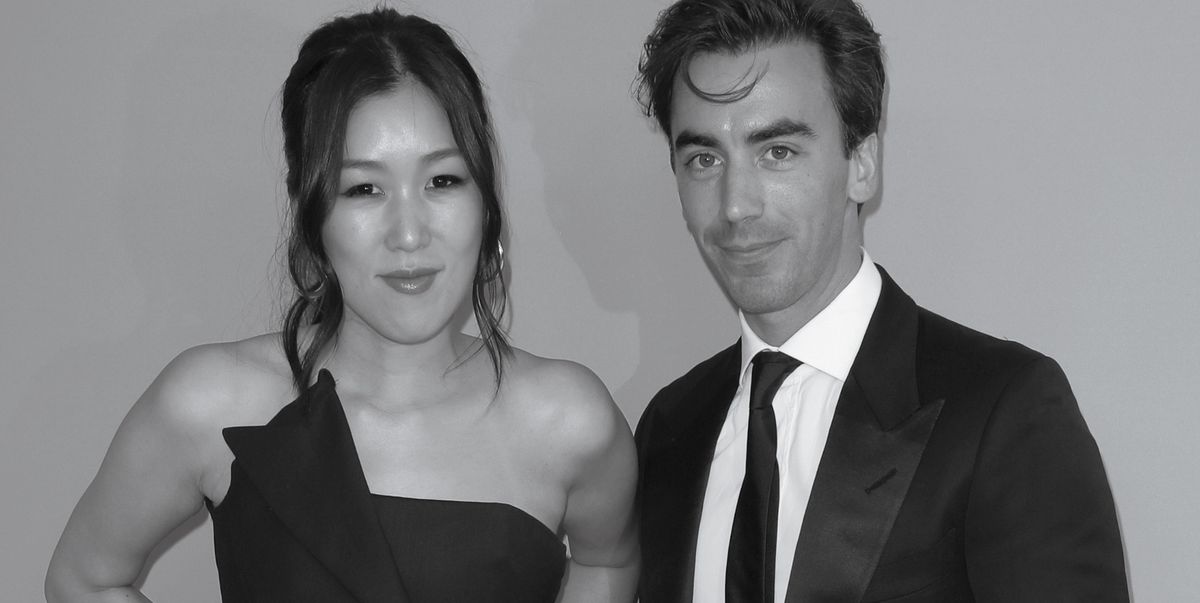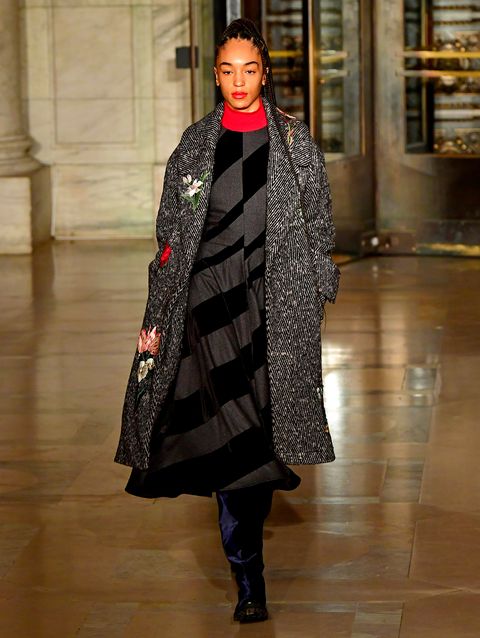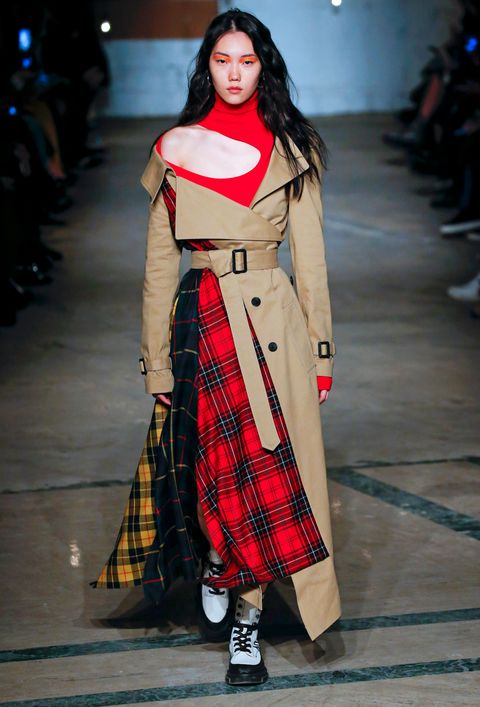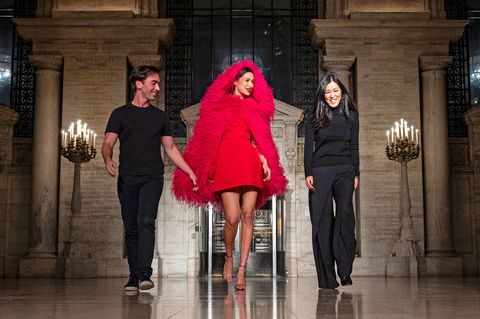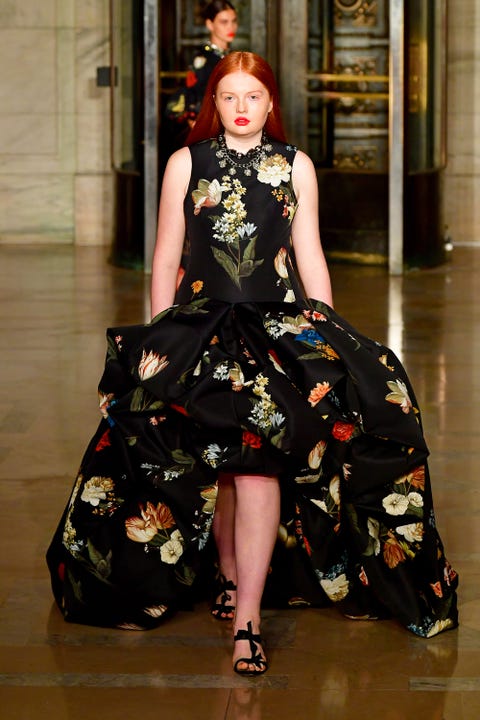This summer, when I spoke with Fernando Garcia and Laura Kim, who are co-creative directors of both Oscar de la Renta and Monse, they said the pace of running two brands meant that working remotely had already become a way of life for them. As Garcia put it, the two “are on our phones no matter what.” But self-isolation has also caused them to re-think some of their usual practices, from sustainability to how they approach their signature eveningwear. Below, as part of ELLE’s look at the future of fashion, they share their thoughts on charting a new way forward.
Do you think this is moment going to push the industry in a better direction, whether it is being more sustainable, changing the way we produce collections, or pushing the industry to be more accountable in terms of including people of color?
Kim: We have been talking to a lot of retailers and designer friends who [split] collections into multiple deliveries. I’ve been talking to Gabriela Hearst a lot…She taught me a lot of things. For both brands, we are trying to use a lot of fabrics that is already existing instead of creating new fabric. Instead of getting it from scratch.
Garcia: It pushes you, creatively, to be sustainable. I think on the diversity front, it always has been a part of Laura’s and my mission, but there is a lot more to learn and take away from it. And we are going to strive to do that.
Kim: I mean if you look at the shows, we are always very diverse in casting.
Garcia: We just have to continue it and further it.
The current limitations are forcing everyone to be creative. How have you been reimagining the ways that you do things?
Garcia: We believe in the value of embroidery. That’s something that is part of the DNA of a brand, and that’s part of what our customers expect. But given the current climate, we have to come up with ways to perhaps manipulate fabric to get that impact, that texture, that our collections have always had. That’s something that we are trying to become more innovative and creative about.
Kim: I’m trying to produce as much as I can in New York. We’re going to save on our carbon footprint.
Are there things that you’ve learned over the past few months that have influenced your work or you feel will influence the industry going forward? What you think we will see in terms of what customers want and how their approach to fashion will change?
Kim: I think for next year, the customers, even Oscar customers, are going to look for something cheaper, but we have to make sure we are true to our brand, what we show, and not sacrifice the quality.
Garcia: To piggyback on what Laura is saying, everybody should focus on who they are as a brand because of the frugality that our customers are going to have now. They’re going to want something that looks quintessential Oscar and quintessential Monse, to feel like they got their money’s worth.
Do you think there will be a point where the pendulum will shift and people will say: “I’ve been in sweatpants for three months and I want to dress up again?” When these events obviously aren’t taking place, how does eveningwear evolve?
Kim: I think there’s going to be a lot more of small gatherings of friends. We’ve been trying to see what’s a home entertainment look that’s not too casual but not too fancy. That’s where our minds are at.
Do you have any thoughts on how fashion shows and fashion weeks will change? Are there other, more innovative ways to show that you think might replace what we’ve been doing?
Garcia: I think every brand, given the current climate, needs to do exactly what feels right for them. There’s no “right” answer that is universal for everybody.
You were working in fashion during the 2008 recession. Are there lessons you took away during that time with how to deal with challenges? Do you think there are any similarities between the two eras, and what lessons did you take away from them that you are using now?
Kim: 2008, what came out of it was contemporary brands. It was a new price point that was missing in the market. I think even now, after all this craziness, whoever stays focused and looks at the market and realizes what’s lacking and goes for it, that’s the one brand that’s going to survive instead of keeping everything the same. I think we have to be very aware of customers’ needs and what’s lacking and go from there.
What do you want to take away from this time and what do you want to leave behind in the pre-COVID era?
Kim: It really gave me time to think through what we are doing and really focus on what we’ve loved to do. I think creative people should push what they are good at, what they love to do. That’s when you get the best work.
Garcia: We get pulled in a lot of different directions, especially when you’re running two brands, but this definitely forced all of us, everyone on the team, to slow down and think about what is necessary and what is important to continue and move forward.
Kim: And there is material sustainability [as well as environmental sustainability.] My team, their energy can’t sustain [a frenetic] workload, so I think it’s about really focusing on what we love to do and what’s right for the brand.
Garcia: I’ve seen when other brands have a product sitting in the store that looks like you’ve designed it when you are exhausted. It’s possible a customer knows when you’ve created something that is truly original and excited with a smile on your face. You can feel the energy in the clothes when they were designed with proper amount of time. I think this is possibly a good outcome from this crazy situation we are in.
This interview has been edited and condensed for clarity.
Read More on The Future of Fashion
This content is created and maintained by a third party, and imported onto this page to help users provide their email addresses. You may be able to find more information about this and similar content at piano.io
